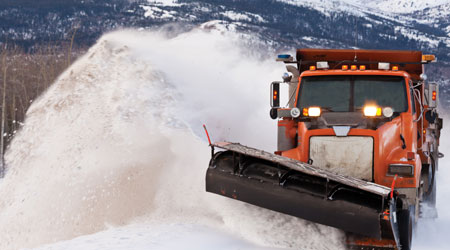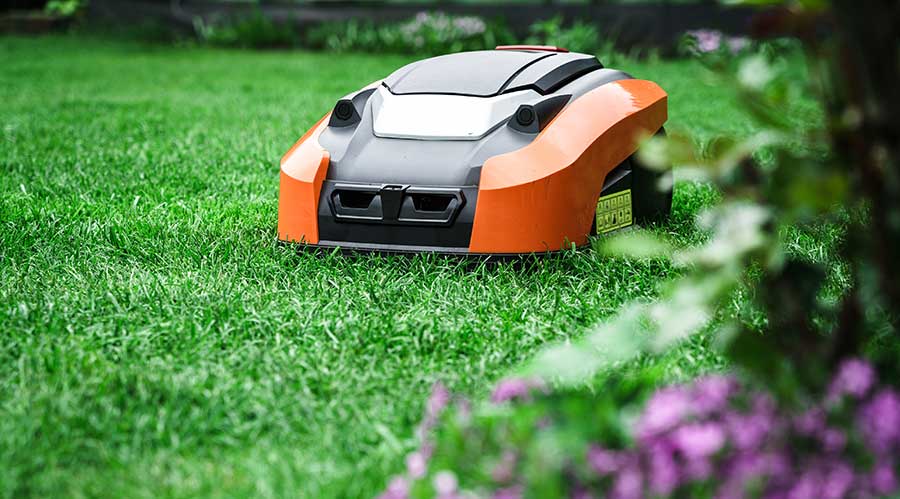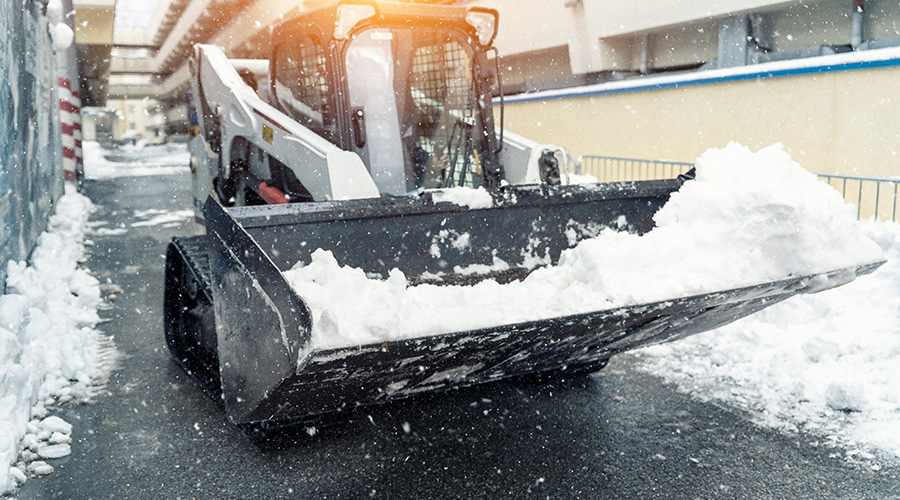 Effective snow and ice management involves preparing staff and equipment for the duties ahead.
Effective snow and ice management involves preparing staff and equipment for the duties ahead.A Blizzard of Challenges in Keeping Schools Open
Snow and ice management for Anchorage School District can mean removing nearly 80 inches of snow annually.
Brad Theisen and his team know a good deal about snow and ice management. Working in Anchorage, Alaska, a city that receives an average of 78.8 inches of snow annually — the average U.S. city receives 28.8 inches — can provide that kind of insight and expertise.
The snowfall in Anchorage, coupled with the length of its winter, offers ample opportunity to fine-tune operations.
“Winter is typically from the middle to end of October to the end of March,” says Theisen, facility maintenance supervisor with the Anchorage School District. “This year, we ran into April.”
A host of challenges
Theisen and his team are responsible for about 300 acres of parking lots and driveways around 97 school district facilities. The sheer size of the district and the range of activities in and around its buildings can present major snow and ice management challenges.
“The two furthest out schools are roughly 70 miles apart, and our parking lots vary in size from 1 acre to over 10 acres,” he says. “The management of a smaller parking lot can be more labor-intensive than the larger one, and no matter how proactive you try to be, you are subject to various things that are at some point out of your control, such as other organizations, equipment issues, staff and the tens of thousands facilities users.”
Amid all of these challenges, the biggest is the weather.
“A 10-degree fluctuation in temperature can change your focus and how you need to address snow and ice mitigation” Theisen says. “With a 10 degree fluctuation, at 22 degrees you're going to get a lot of snow, whereas at 12 degrees, you won't get a lot of snow. At 32 degrees, you're going to get a lot of ice, and you've got to change up for the conditions.
“If you get warmer temperatures, you’ve got to send out sanders. If you get colder temperatures, then you focus more on stripping lots, hockey rinks, the whole thing.”
Theisen oversees 65 personnel, including those responsible for snow and ice management, carpentry, roofing, glass, paint, lock and key, vehicle maintenance, and playgrounds. The winter duties include clearing snow from fire lanes, hockey rinks, fire hydrants, and access gates. The crews also haul snow to designated areas, sand driveways and parking lots, fill sand bins, prepare and maintain hockey rink ice, clear snow from roofs as needed, and respond to any school-initiated requests.
The department divides snow and ice management into maintenance duties — larger areas including parking lots that Theisen and his team are responsible for — and operations.
Despite the division of labor, the two groups collaborate to keep areas around school clear of ice and snow.
“Operations handles everything from the sidewalk in, so anything on the sidewalks, cleaning on the sidewalk,” he says. “We do some ice mitigation or cleaning periodically on sidewalks as needed.
“If operations needs something — say, if their snow blower goes down and our mechanic can't get it up in time, and they have a situation where they need us to jump on the sidewalk — they'll just reach out with the work order, or the principal will call me. I'll coordinate that with the leads, and we'll get the guys out there to clean their sidewalks or fill their sand bins or whatever they need.”
Equipment considerations
Theisen and his team rely on a range of snow removal equipment to keep parking lots clear. The arsenal includes graders, loaders, skid steers, backhoes, trackless snow blowers, and plow trucks.
Smaller equipment is dispatched to handle the district’s smaller schools and lots, Theisen says, adding “the graders, loaders and plow trucks hit the larger schools. The graders will go back through all the schools to clean up issues that the plow trucks couldn’t, and the plow trucks will be used for other operations, like fire lanes and hockey rinks and anything of that nature.”
The operations teams use an array of snowblowers to keep sidewalks and entryways clear.
“Operations utilizes walk-behind snowblowers more than maintenance does,” he says. “They have, I would say, hundreds of snow blowers. Each facility will have a snow blower, and then they'll also have riding equipment, riding snow blowers, and some even have skid steers at their schools.”
Replacing snow and ice management equipment involves a team approach that includes the maintenance lead, maintenance supervisor, assistant director of business operations and maintenance, director of maintenance and operations, and senior director of maintenance and operations.
“We analyze how the current equipment works, and then we look at other options,” Theisen says. “If it's a loader, we'll look at (several manufacturers) and see what has functioned for us best over the years. Then we just go off of that and decide what we're going to look for.”
One goal of the equipment replacement process is minimizing the number of different manufacturers.
“We like to standardize our equipment as much as possible, so if we can get all (one manufacturer), we prefer that,” he says. “It's easier on the mechanics, it's easier on us, and it just works better.”
Preparing for action
As all grounds managers know, snow and ice management is not a six-month process. It’s a year-round responsibility.
“During the spring and summer months, we evaluate and repair snow removal and rink maintenance equipment, look at the impact of on-site snow storage and snow removal operation, sweep winter aggregate from parking and driveways, purchase tools needed for winter operations, and work with purchasing to receive winter aggregate and salt and with contractors to clear snow at some charter schools,” Theisen says.
Even the actual snow and ice season involves more than removing those materials from parking lots and sidewalks.
“In winter and fall months, we receive prep winter aggregate and evaluate winter operations effectiveness by constantly looking for ways to improve,” Theisen says.
Preparation for snow and ice management also involves preparing staff for the duties ahead.
“Staffing and training challenges can be complex,” he says. “Getting a new employee trained on sites and snow and ice management can take years. To address these challenges, we typically pair up the less experienced with a more knowledgeable team member.”
Training often starts with becoming familiar with the department’s equipment.
“We'll go over the equipment and explain everything about the equipment and the safety aspects of it,” he says. “Then we'll go into the layouts. We'll give them a route of maybe 10 schools, and they'll go look at all the layouts of those 10 schools and find where to push the snow.
“We can't push up toward the school, so you want to show them key locations where to put the snow as they're plowing to facilitate the removal or not block parking spaces or not choke off driveways or sidewalks. There are a lot of factors that go into just the site layout and how we push snow.”
The dealers and manufacturers of snow management equipment also play a role in acclimating operators to new products.
“If we get new equipment, we'll call in a dealer trainer,” Theisen says. “For the (new) graders, we’re calling them, and they can go over the equipment with our operators and explain it. But for the most part, it's in-house other than safety related items. It's really easy to pull up a video, put it on TV and have them watch the video. Then we'll walk through some extra points afterwards.”
Making the program work
One common component of many snow and ice management programs is missing from the Anchorage School District.
“We do not utilize chemicals in management efforts,” Theisen says. “It's based on a policy from the school board about the effects they could have on students and staff.
“We've chosen to move away from any chemicals, and that even goes with lawn maintenance, and we don't use any weed and feed. The only thing we might use is fertilizer and lime in the summers, but that's about the extent of it as far as the grounds maintenance and snow removal.”
Instead, the department uses sand on the district’s driveways and parking lots.
As colder weather approaches, Theisen and his team know they again will have their work cut out for them, given the amount of snow they will have to deal with this winter. They also know that because they tend to work early mornings and late nights, the work is not likely to be seen by many people in the district. The out-of-sight, out-of-mind attitude often means their work goes unappreciated.
“A lot of people think that anybody can plow snow, but when you get into big operations like this, they need to be plowed effectively,” Theisen says. “We only have 10 hours to open up that 300 acres unless we come in two hours early. It's a really tight time frame because if we don't open up those schools, then the kids can't get to the schools, and then that just snowballs, if you will.”
Dan Hounsell is senior editor for the facility market. He has more than 25 years of experience covering engineering, maintenance and grounds management issues in institutional and commercial facilities.
Related Topics:













